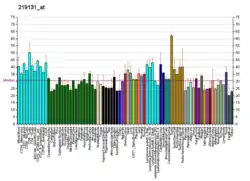UBIAD1
UbiA prenyltransferase domain-containing protein 1 (UBIAD1) also known as transitional epithelial response protein 1 (TERE1) is a protein that in humans is encoded by the UBIAD1 gene.[5][6][7]
The enzyme is named for its canonical role in ubiquinone production. Recent evidence suggests that ubiad1 has enzymatic activity in the vitamin K pathway, a role in blood vessel development, and may be involved in oxidative stress pathways.[8][9][10]
Clinical significance
Mutations of the UBIAD1 gene cause Schnyder crystalline corneal dystrophy.[11][12]>[13]
References
- GRCh38: Ensembl release 89: ENSG00000120942 - Ensembl, May 2017
- GRCm38: Ensembl release 89: ENSMUSG00000047719 - Ensembl, May 2017
- "Human PubMed Reference:". National Center for Biotechnology Information, U.S. National Library of Medicine.
- "Mouse PubMed Reference:". National Center for Biotechnology Information, U.S. National Library of Medicine.
- McGarvey TW, Nguyen T, Puthiyaveettil R, Tomaszewski JE, Malkowicz SB (Dec 2002). "TERE1, a novel gene affecting growth regulation in prostate carcinoma". Prostate. 54 (2): 144–55. doi:10.1002/pros.10174. PMID 12497587. S2CID 12942882.
- McGarvey TW, Nguyen T, Tomaszewski JE, Monson FC, Malkowicz SB (Apr 2001). "Isolation and characterization of the TERE1 gene, a gene down-regulated in transitional cell carcinoma of the bladder". Oncogene. 20 (9): 1042–51. doi:10.1038/sj.onc.1204143. PMID 11314041.
- "Entrez Gene: UBIAD1 UbiA prenyltransferase domain containing 1".
- Nakagawa K, Hirota Y, Sawada N, Yuge N, Watanabe M, Uchino Y, Okuda N, Shimomura Y, Suhara Y, Okano T (November 2010). "Identification of UBIAD1 as a novel human menaquinone-4 biosynthetic enzyme". Nature. 468 (7320): 117–21. Bibcode:2010Natur.468..117N. doi:10.1038/nature09464. PMID 20953171. S2CID 9385489.
- Fredericks WJ, McGarvey T, Wang H, Lal P, Puthiyaveettil R, Tomaszewski J, Sepulveda J, Labelle E, Weiss JS, Nickerson ML, Kruth HS, Brandt W, Wessjohann LA, Malkowicz SB (November 2011). "The bladder tumor suppressor protein TERE1 (UBIAD1) modulates cell cholesterol: implications for tumor progression". DNA Cell Biol. 30 (11): 851–64. doi:10.1089/dna.2011.1315. PMC 3206744. PMID 21740188.
- R Postel, Identification and Characterization of Novel Genes by Reverse and Forward Genetics in Zebrafish, igitur-archive.library.uu.nl/dissertations/2008-0522.../UUindex.html, 2008.
- Weiss JS, Kruth HS, Kuivaniemi H, Tromp G, White PS, Winters RS, Lisch W, Henn W, Denninger E, Krause M, Wasson P, Ebenezer N, Mahurkar S, Nickerson ML (November 2007). "Mutations in the UBIAD1 gene on chromosome short arm 1, region 36, cause Schnyder crystalline corneal dystrophy". Invest. Ophthalmol. Vis. Sci. 48 (11): 5007–12. doi:10.1167/iovs.07-0845. PMID 17962451.
- Orr A, Dubé MP, Marcadier J, Jiang H, Federico A, George S, et al. (August 2007). "Mutations in the UBIAD1 gene, encoding a potential prenyltransferase, are causal for Schnyder crystalline corneal dystrophy". PLOS ONE. 2 (8): e685. Bibcode:2007PLoSO...2..685O. doi:10.1371/journal.pone.0000685. PMC 1925147. PMID 17668063.
- Weiss JS, Kruth HS, Kuivaniemi H, Tromp G, Karkera J, Mahurkar S, Lisch W, Dupps WJ, White PS, Winters RS, Kim C, Rapuano CJ, Sutphin J, Reidy J, Hu FR, Lu da W, Ebenezer N, Nickerson ML (February 2008). "Genetic analysis of 14 families with Schnyder crystalline corneal dystrophy reveals clues to UBIAD1 protein function". Am. J. Med. Genet. A. 146 (3): 271–83. doi:10.1002/ajmg.a.32201. PMID 18176953. S2CID 24627267.
Further reading
- Maruyama K, Sugano S (1994). "Oligo-capping: a simple method to replace the cap structure of eukaryotic mRNAs with oligoribonucleotides". Gene. 138 (1–2): 171–4. doi:10.1016/0378-1119(94)90802-8. PMID 8125298.
- Suzuki Y, Yoshitomo-Nakagawa K, Maruyama K, et al. (1997). "Construction and characterization of a full length-enriched and a 5'-end-enriched cDNA library". Gene. 200 (1–2): 149–56. doi:10.1016/S0378-1119(97)00411-3. PMID 9373149.
- Strausberg RL, Feingold EA, Grouse LH, et al. (2003). "Generation and initial analysis of more than 15,000 full-length human and mouse cDNA sequences". Proc. Natl. Acad. Sci. U.S.A. 99 (26): 16899–903. doi:10.1073/pnas.242603899. PMC 139241. PMID 12477932.
- Gerhard DS, Wagner L, Feingold EA, et al. (2004). "The Status, Quality, and Expansion of the NIH Full-Length cDNA Project: The Mammalian Gene Collection (MGC)". Genome Res. 14 (10B): 2121–7. doi:10.1101/gr.2596504. PMC 528928. PMID 15489334.
- McGarvey TW, Nguyen TB, Malkowicz SB (2005). "An interaction between apolipoprotein E and TERE1 with a possible association with bladder tumor formation". J. Cell. Biochem. 95 (2): 419–28. doi:10.1002/jcb.20432. PMID 15782423. S2CID 43563999.
- Otsuki T, Ota T, Nishikawa T, et al. (2007). "Signal sequence and keyword trap in silico for selection of full-length human cDNAs encoding secretion or membrane proteins from oligo-capped cDNA libraries". DNA Res. 12 (2): 117–26. doi:10.1093/dnares/12.2.117. PMID 16303743.
- Gregory SG, Barlow KF, McLay KE, et al. (2006). "The DNA sequence and biological annotation of human chromosome 1". Nature. 441 (7091): 315–21. Bibcode:2006Natur.441..315G. doi:10.1038/nature04727. PMID 16710414.
- Yellore VS, Khan MA, Bourla N, et al. (2007). "Identification of mutations in UBIAD1 following exclusion of coding mutations in the chromosome 1p36 locus for Schnyder crystalline corneal dystrophy". Mol. Vis. 13: 1777–82. PMID 17960116.
This article is issued from Wikipedia. The text is licensed under Creative Commons - Attribution - Sharealike. Additional terms may apply for the media files.




